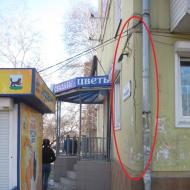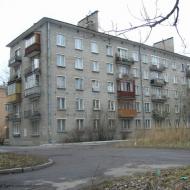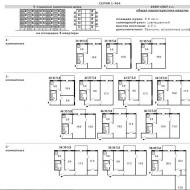
General characteristics of microeconomics and its economic market categories. Microeconomic object. The problem of choice as the main object of microeconomic analysis Test questions and tasks
Features of the subject of microeconomics
The subject of the study of microeconomics is the patterns of behavior and decision-making of primary economic units - households and firms, as well as the peculiarities of the formation due to their interaction of higher-order structures - markets for individual goods and industries. In other words, microeconomics studies economic behavior producers, consumers, owners of production and financial resources as well as the functioning of various types of market structures and individual industries.
Microeconomics studies individual economic units and forms a view of the entire economy from the point of view of these units.
Microeconomics is the science of decision making that studies the behavior of individual economic agents. Her main problems:
1) prices and volumes of production and consumption of specific goods;
2) the state of individual markets;
3) the distribution of resources between alternative goals.
Microeconomics studies relative prices, that is, the ratio of prices of individual goods, while the absolute level of prices is studied by macroeconomics.
The immediate subject of microeconomics is economic relations associated with effective use limited resources, decision-making by individual subjects of the economy in conditions of economic choice.
Let us clarify the above definitions of the subject of microeconomics.
First. Under the conditions of the law of scarcity of resources, microeconomics formulates the basic principles of rational behavior of all types of economic entities, including enterprises, firms, households, etc., studies the mechanism for making optimal management decisions.
Second. Microeconomics reveals the content of economic and social efficiency, develops criteria and relevant indicators that are used in assessing the final results of management.
Third. Modern microeconomics can be represented as a set of theories, including the theory of production, the theory of the firm, the theory of pricing, the theory of the development of market relations and antitrust regulation, and finally, the theory of production costs, income and profit.
These theories and other concepts, given in a rigorous system, act as the most important components of modern micro economic analysis.
Fourth. Microeconomics studies the economic relations arising in the process of production, exchange, distribution and consumption of material goods at the level of economic entities. Revealing the content of these relations, modern microeconomics explores the relations of appropriation and property, the formation and development of economic interests business entities.
microeconomics science analysis
Microeconomic object. The problem of choice as the main object of microeconomic analysis
The object of microeconomics is the economic activity of people and the resulting general economic problems solved in accordance with existing institutions and their systems.
In microeconomics, the study of the following issues is of particular importance:
1) the economic behavior of people, anchored in adequate institutions and social structures. The market, property and state are the key institutions;
2) decision-making by economic entities and their implementation of relevant economic actions;
3) the problem of choosing one of the alternative options for using resources;
4) it touches upon the question of the rarity of goods and their limitations.
The main task of economic agents of microeconomics is to implement economic choice due to limited resources. In any society, limited resources force choices to be made to address the following issues:
1. What to produce and to what extent.
The manufacturer always has the option of alternative production. To select an acceptable production option, it is necessary to study consumer needs, the satisfaction of which is the ultimate goal of any production.
2. How to produce the selected types of goods.
The manufacturer must decide what resources and how much to involve in the production process. By examining the theory of production, microeconomics helps to clarify the mechanism for the allocation of resources between enterprises and industries.
3. For whom to produce, who will receive the manufactured products.
4. How much resources to use for current consumption and how much - for the future.
The last two questions are related to the study of income and their distribution to current and future consumption. The resources can be used for immediate consumption, or some of the resources can be used for future consumption. A decision must be made as to how much of the income to keep to finance investment in the economy, to increase production capacity, to accumulate savings in the family.
Thus, the main problem that microeconomics deals with is the problem of choice in a market economy. All subjects of the economy stand before it. It is known that in economics the problem of choice arises primarily due to limited resources and unlimited needs. V market economy it becomes very complex and capacious in its content already due to its existence economic freedom from subjects of the economy.
First of all, the problem arises of choosing the goals of economic activity, which may be different for different subjects of the economy. But if we talk about the goals of commodity producers, then microeconomics reduces them to maximizing profits. When a commodity producer becomes a seller, his goal is to maximize the income received from the sale of the commodity. The goal of the buyer is considered to be the maximization of the acquired utility, and the goal of the consumer is the maximum satisfaction of needs with the given expenses for the acquisition of commodity goods.
The noted goals of various subjects of microeconomics can be achieved in different ways. So, making a profit is possible as a result of the production and sale of a wide variety of goods. This means that the manufacturer is faced with the problem of choosing a profitable product. How such a choice is made, what rules should be followed in this case - all this explains microeconomics. This science explains and the behavior of consumers when choosing commodity goods in order to maximize the degree of satisfaction of their needs.
Determination of the goal also presupposes the choice of means to achieve it. In any economy, this means the choice of resources and the choice of ways, ways of using them. In a market economy, for enterprises as commodity producers, along with labor, capital, material and natural resources monetary resources that can be converted into any resources, both for production and non-production purposes, are acquiring great importance.
Microeconomics explains how the problem of alternative use of limited, or rare, resources by both producers and consumers is solved.
It is well known that the desire of a person to maximize consumption and minimize his participation in production characterizes him as a rational person. It is the rational person that is the object of attention of microeconomics. That is why microeconomics is also called the science of the rational behavior of the subjects of a market economy.
Microeconomics believes that it is the market that helps to make effective economic decisions by sending appropriate impulses and signals to rational actors. Competition and prices play a decisive role in this. Competition forces you to make effective decisions and actions, and prices provide the information you need to do this. Thanks to them, producers know what, how much, how and for whom to produce, and consumers - what and how much goods to purchase with minimal costs for them and how to consume them (in what combination) to maximize their needs.
That is why microeconomics pays considerable attention to the functioning of the market mechanism, the laws to which it obeys, and how it determines the behavior of economic entities.
We examined in detail two parts of the system. economic relations:
a) socio-economic relations based on property and
b) organizational and economic relations.
Now, in the future, the main forms will be analyzed (disassembled) economic activity:
microeconomics,
macroeconomics and world economy.
All these forms of management have their own characteristics of the types of economic relations we have considered: a) property, b) cooperation and division of labor, c) forms of economic organization and d) economic management. In this regard, it is important to understand the distinctive features of microeconomics, macroeconomics and the world economy, as well as their characteristic features of economic relations. These forms of economic activity differ primarily in their scale. Microeconomics- is farming in small forms (within households and small enterprises), macroeconomics- creative activity within the borders of the country, and the world economy encompasses economic relations on a global scale.
Microeconomics includes two forms of activity - households and comparatively small businesses.
What counts as a household World statistics (the science that studies the quantitative indicators of the development of society) believes that the household is a collection of people who live in the same dwelling or part of it. They can be either related by kinship relations or not, jointly provide themselves with food and everything necessary for life. That is, members of the household, in whole or in part, pool and spend their funds. A household can also consist of one person living independently. Household- this is common household led by a group of people living together.Rice. 4.1. Structure of actual final consumption of households in Russia in 2003
As can be seen from the diagram shown in Fig. 4.1, the actual consumption of households in Russia ultimately consisted of the following parts:
purchases of goods and payment for services (77.6%),
social payments from state and municipal budgets and charitable foundations (15.8%),
receipts of goods and services in kind (6.6%).
The household is not just a consumer association of people. It also deals with economic activity, which brings a variety of income.
These activities include:
1) receiving income from the sale of factors of production (for example, labor) and from property (rent for housing and land, interest on the deposit of money in a bank, income from shares, etc.);
2) housekeeping (work in the subsidiary agriculture, purchase of consumer goods and services, home cooking and other products, consumption of material and spiritual goods);
3) education of the younger generation;
4) "external" economic relations (paying taxes to the state, receiving social payments from the state, economic relations with abroad, including receiving remittances, parcels, etc.).
In the XIX-XX centuries. the number of relatively small enterprises in common shared ownership (partnerships, cooperatives, joint-stock companies) has increased significantly. This strengthened the economic position of small entrepreneurs.
The most important reasons for the sustainability of microeconomic farms are:
their flexibility - quick adaptation to changes in consumer needs;
the need to service small volumes of market transactions. Examples include the sale of clothing, footwear, taking into account the non-standard needs of buyers; repair work (they are carried out by firms that repair watches, shoes, cars); provision of personal services (family doctor, lawyer, hairdresser); stores of extremely expensive goods for people with very high incomes (luxury yachts, high-quality sports cars, etc.);
highly specialized production of components for large assembly plants; product sales large companies(TVs, refrigerators, washing machines);
the use of modern microprocessor technology, which gives a large economic effect and in small businesses.
In highly developed countries, small businesses play a very important role in the economy: they create about 1/2 of the country's total national product. The state provides small business assistance with financial (monetary) means, reduces taxes.
Send your good work in the knowledge base is simple. Use the form below
Students, graduate students, young scientists who use the knowledge base in their studies and work will be very grateful to you.
Similar documents
- Microeconomics uses the following types property: a) private ownership of property; b) general shared ownership(with the determination of the share of each owner of the property) and c) the total joint ownership(without defining such shares).
- Usually, in microeconomics, products are produced on the basis of a narrow specialization (one type of product is made or some kind of service is performed, for example, in a hairdressing salon).
- Entrepreneurial activity in micro-farms is associated with the production of goods, as well as with their sale and purchase on the market.
- The management of a micro-farm is under the jurisdiction of the owners of private or common property.
- Topic 2. General characteristics of the functioning of the market mechanism
- 2. 1. Fundamentals of the functioning of the economy at the micro level. The concept of scarcity in economics
- Topic 3. Firm and forms of entrepreneurial activity
- 3.1. Place of the enterprise (firm) in the economic system
- 3.2. Individual private enterprises, their advantages and disadvantages
- 3.3. Partner enterprises (or partnerships) and societies
- 3.4. Joint-stock companies and their types
- 3.5. Joint ventures
- 3.6. State-owned enterprises (public corporations)
- Chapter 4. Costs and income of the enterprise
- 4.1. Enterprise funds as the material basis of its commercial activities
- 4.2. Enterprise costs, their types and composition
- 4.3. Gross revenue and profit of the enterprise
- Method of comparing gross income and gross costs
- Method of comparing marginal revenue with marginal cost
- Equilibrium of the firm in the long run
- 4.4. Minimization of costs in the selection and use of factors of production
- Part 2. Consumption
- Topic 5. Rational consumer as a subject of a market economy
- 5.1. Consumer choice and the rules of rational consumer choice
- Changes in the prices of goods and budget constraints.
- Part 3. Exchange
- Chapter 6. Market as a sphere of commodity exchange
- 6.1. Market as a category of microeconomics
- 6.2. Types and types of markets
- 6.3. Organizational Forms of Consumer Goods Markets
- 6.4. Organizational Forms of Factor Markets
- Topic 7. Supply and demand functions. Market equilibrium and disequilibrium
- 7.1. Supply and demand: essence and determinants
- Engel's law.
- Compensating changes. Taxation and consumer welfare.
- 7.2. Market equilibrium and non-equilibrium. Equilibrium mechanisms. Cobweb model.
- Market equilibrium:
- Topic 8. Elasticity in the analysis of supply and demand
- 8.1 Types of elasticity: point, cross and arc.
- 8.2 Elastic and inelastic demand. Unit Elasticity Demand. Linear demand function and its elasticity. Income elasticity of demand.
- Income Elasticity of Demand
- 8.3. Elastic and inelastic offer.
- 8.4. Sales revenue and price elasticity of demand. Cases of unit elasticity of demand.
- Total consumer spending (or revenue from sellers) due to price changes
- Topic 9. Monopoly. Imperfect Competition and Market Power Market Power and Social Welfare
- 9.1 The concept of market structure and the main types of market structures: perfect competition, monopoly, oligopoly and monopolistic competition
- 9.2. Monopoly and its features
- Part 4. Distribution
- Chapter 8. Labor market and wages
- 8.1. Wages as the price of labor
- 8.2. Labor market supply and demand and wages
- 8.3. Forms and systems of wages
- Chapter 9. Loan market and interest
- 9.1. Features of capital as an object of remuneration
- 9.2. Loan capital and its features
- 9.3. Interest as the price of loan capital
- 9.4. Supply and demand in the capital markets
- 9.5. Credit, its forms and role in the economy
- Chapter 10. Rent. The form of remuneration for land as a factor of production
- 10.1. The economic essence of rent
- 10.2. Differential land rent
- 10.3. Theories of absolute and monopoly rent
- 10.4. Land price. Supply and demand in the land market
- Chapter 11. Profit as remuneration for entrepreneurial activity
- 11.1. Entrepreneurship and profit
- 11.2. Essence, forms and factors of profit
- 11.3. The role of profit in a market economy
- Recommended reading list Main
- Additional
The essence of microeconomics as a science. Positive and Normative Microeconomics. Its basic functions, based on the provisions of the fundamental economic theory... Objects and methods of microeconomic analysis. Resource constraints as the main problem.
abstract, added 01/14/2016
Microeconomics as the first level of economic theory. Purpose and specificity of micro- and macroeconomic analysis... The problem of choosing the optimal solution. Production possibilities frontier. The law of increasing opportunity costs and the CPV model.
presentation added on 12/27/2012
Acquaintance with the subjects and objects of study of modern microeconomics. general characteristics methods of economic analysis of microeconomic theory. Consideration of levels economic science... Features of the specifics of the microeconomic approach.
thesis, added 01/08/2015
Microeconomics as an integral part of fundamental economic science, the subject and methods of its study, areas of activity, object and subject of its research. Methodology, general scientific and particular methods of cognition of modern microeconomics, its main functions.
term paper, added 09/05/2009
Microeconomics as a special section in the fundamental course of economic theory, its significance, subject and basic methods of economic analysis. The behavior of individual economic agents. Microeconomics and Business Practice. The levels of economics.
abstract, added 06/10/2014
The main functions of economic theory. Economic research methods. Methodology of microeconomics - methods of cognition of economic relations and processes at the level of individual economic units. Economic entity microeconomics, basic schools.
presentation added on 05/15/2014
The field of microeconomic analysis. Organization of the distribution of limited resources and production results between alternative goals and subjects of competition. Foundations of the theory of production and supply of goods. The main provisions of the theory of competition.
Features of microeconomics
Microeconomics(from the Greek. micros - small + economy) - part national economy, which differs from other sectors of production in small size. Specific traits microeconomics are shown in table. 1.
Table 1
Characteristics of microeconomics
Here is a brief explanation of Table. 1.
Microeconomics could not arise and develop widely in a social system based on non-economic coercion of people to work. This economy has its own historical roots. In Europe, it was formed in the XV-XVI centuries. Then capitalism came to replace feudalism with its serfdom. The latter approved civil liberties and a new economic basis societies: private ownership of the means of production and free enterprise.
Microeconomics in Russia has developed in a completely different and very contradictory way. In this regard, it is important to clarify the following problem of a theoretical and practical nature.
V Problem 2.1. When and how was microeconomics formed in our country?
The radical transformation of property relations in Russia is clearly illustrated by Table. 2.
table 2
% to the bottom line
However, the process of the formation of microeconomics in Russia has not been fully completed. This is evidenced by the following comparative data. V Western countries small and medium-sized enterprises account for 70% of all enterprises, and in our country - 20%. It is noteworthy, for example, that there were 4 million small businesses with less than 20 employees in Italy, and 6 million in the USA.
In 2010, in our country, there were 17 thousand medium-sized, 228 thousand small companies (associations of physical and legal entities), more than 1 million micro-enterprises, 4 million individual entrepreneurs and farmers. According to Russian legislation Limit levels for small businesses are set in different industries: from 30 to 100 people.
To accelerate the development of small and medium-sized businesses Russian government has outlined and is implementing a number of urgent measures.
First, the government has introduced a ban on unjustified interference by officials of all levels in business. Such interference and frequent inspections of enterprises were often carried out by employees of municipalities for selfish purposes.
Secondly, privatization continued state property... It's about stepping up the foreclosure real estate leased by entrepreneurs. It is noticed that municipal bodies, instead of opening the way for entrepreneurs, they lease their property for the sake of obtaining income The government extends the term preferential order privatization of real estate (with the exclusion of part of taxation). Almost a million small and medium-sized entrepreneurs have been given the right to purchase leased premises for preferential terms before July 1, 2013
Third, small businesses are now more widely involved in renovation programs. apartment buildings and resettlement of emergency housing.
In early 2010, the government allocated 13 billion rubles. to assist in the development of small and medium-sized businesses.
1.3. Features of the methods and functions of microeconomics as a science
The specificity of the subject of microeconomics as a science determines the peculiarities of its methods. Since the subject of microeconomics is the behavior of economic entities, the observation method is of particular importance in microeconomics. It is about observing the behavior of people as producers and consumers, buyers and sellers, which makes it possible to identify the factors that determine this or that behavior, the presence of patterns of their action.
The most important method of economics as a science is the method of abstraction. This method is especially widely used by microeconomics in the study of the market mechanism, its constituent elements, the behavior of buyers and sellers, etc. Although microeconomics deals with markets for individual goods, it considers the market in general in its abstract form, which helps to better understand the economic content of the market, the mechanism of its functioning.
The method of microeconomic analysis is characterized by a certain specificity. In particular, the method of functional analysis is widely used, which requires consideration of certain elements of the economy, taking into account the impact on them of various factors. As a result, one object under consideration appears as a function, the other as an argument. In this case, the method of assumptions is quite often used, which involves the analysis of the impact of one factor on another "with other unchanged conditions."
The method of limiting analysis plays an important role in microeconomics. It involves taking into account changes in the form of an increase in certain results of economic activity: costs, income, product, utility, etc.
This, in turn, determines the special importance of the statistical method, which allows obtaining the data necessary for analyzing the conditions of individual markets, enterprises, and dividing them, however, like consumers, into certain types, types, categories.
This method is often used in conjunction with the method of accounting for the equilibrium and non-equilibrium states of the objects under study: markets requiring the ratio of income and expenses of commodity producers, prices and utilities of consumed goods, etc. Economic and mathematical methods, modeling methods, graphic methods are widely used.
As for the functions of microeconomics as a science, then, like economic theory as a whole, it is possible to distinguish theoretical-cognitive, predictive, methodological and practical functions. However, performing the first function and acting as a positive science, microeconomics explains economic phenomena at the micro level - the level of individual enterprises, households, and markets for individual goods. Many conclusions and provisions of this science are not always applicable to the macrolevel. Accordingly, forecasts given by microeconomics do not always come true for the entire national economy.
Microeconomics asserts that an increase in prices for a product leads to an increase in its supply on the market, but in the economy as a whole, an increase in prices for the entire mass of commodities does not always imply an increase in the volume of national production.
The methodological function of this science is also limited to the micro level. Microeconomics appears as the methodological basis of specific economic disciplines studied by those who intend to become entrepreneurs or work in enterprises as managers, marketers, accountants, auditors, etc.
As for the practical function, it lies in the fact that many provisions of microeconomics are important for all subjects of the economy, which, in one way or another, act as micro-subjects: producers, consumers, buyers, sellers. For example, knowing the theory of consumer behavior, each person as a consumer can use the income at his disposal more rationally. Thus, microeconomics appears as a normative science.
An important feature of microeconomics as a science is that its provisions can be laid in the basis of economic policy, carried out not only at the microlevel, but also at the macrolevel. This means that microeconomics has an impact on the state, which appears primarily as a subject of macroeconomics. So, certain provisions of microeconomics help the state to make the right decisions in the field of tax policy, the social sphere, when pursuing a policy of prices and incomes.
Test questions and tasks
1. What is hidden behind the concept of "microeconomics"? What is the object of study from the side of microeconomics as a science?
2. What is the subject of microeconomics? What is the complexity and specificity of this subject? What is meant by an "atomized" subject of a market economy?
3. Why is the issue of choice a major focus of microeconomic attention? What is the meaning of this science in the concept of "rarity"? Why is this concept closely related to the concept of "efficiency"?
4. Why has the market become the main focus of microeconomics as a science?
5. What methods does microeconomics use to study economic phenomena? What are the features of the application of general economic methods by this science?
6. Expand the functions of microeconomics as a scientific discipline. What is the positive and normative nature of microeconomics?
| " |















